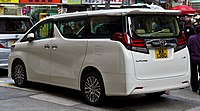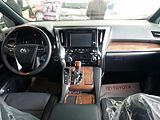Toyota Alphard
| Toyota Alphard | |
|---|---|
| Production period: | since 2002 |
| Class : | Van |
| Body versions : | Station wagon |
The Toyota Alphard is a luxury van built by the Japanese automaker Toyota since 2002. The car is available as a 7- or 8-seater, with 2.4 l or 3.0 l petrol engines and in three different equipment lines - Alphard G , Alphard V and Alphard Hybrid . The Alphard is mainly built for the Japanese market, but is also exported to Indonesia , Hong Kong , Bangladesh , Singapore , Thailand , Malaysia and Russia . The car was named after the Alphard , the brightest star in the constellation of the water snake (Hydra) .
description
Toyota states that their E-Four Electric 4WD system controls the rear-mounted electric motor that drives the rear wheels and coordinates the distribution of electrical energy to all four wheels. An electronically monitored brake system (ECB) ensures effective brake control on every wheel.
The large Van Alphard Hybrid is classified in the USA as a vehicle with particularly low emissions and achieves 75% lower emissions than the Japanese government prescribed in 2000. The 2.4 l engine was developed for use in Toyota's hybrid vehicles , it has low internal friction and is therefore particularly fuel-efficient.
In 2006 the Alphard Royal Lounge was introduced. It is a 4-seater luxury version of the Alphard. Its traditional competitor is the Nissan Elgrand .
"By-Wire" technology
The Alphard Hybrid has an electric brake system that measures the brake pressure correctly depending on the pressure on the brake pedal and the speed of the vehicle. This by-wire technology works together with the E-Four system to convert as much kinetic energy as possible from braking into electrical energy.
The Alphard Hybrid Van can thus create electrical outputs of up to 1,500 W and is equipped with 100 V AC sockets, which (in the USA) allow the supply of many pieces of equipment such as laptops, emergency lights, etc. The sockets can also be used to recharge electric bicycles and other equipment.
The Alphard Hybrid also has a number of safety features that you won't find in other hybrid vehicles. They are supplied as standard with version G and on request with the other versions, together with Toyota's G-BOOK DVD navigation system :
- Camera monitor system for the blind spots, which shows the movement of pedestrians or vehicles.
- Reversing camera monitor system with acoustic guidance that uses signals from the steering to calculate and display the likely possible reversing distance.
- Lane departure warning system that uses the images from the reversing camera to calculate the distance to white or yellow lines on motorways and gives an acoustic signal when the vehicle is too close.
- Distance radar , which uses radar sensors and steering signals to determine the distance to the vehicle in front and gives acoustic warning signals when the vehicle is too close.
Electronic payment system for road tolls
In addition, an electronic payment device for road tolls is available for each equipment line (only together with the navigation system), which enables toll gates to be driven through without stopping.
The Alphard Hybrid consumes approx. 6.2 l / 100 km, has a thermal insulation of the body and a new two-way compressor on the engine, which optimizes the air consumption of the air conditioning system and thus saves fuel. The specially developed windshield also reduces the heating of the vehicle when exposed to sunlight. The roof is also insulated and contributes to a low temperature in the interior.
1st generation (2002-2008)
| 1st generation | |
|---|---|
|
1st generation Toyota Alphard |
|
| Production period: | 2002-2008 |
| Body versions : | Station wagon |
| Engines: |
Gasoline engines : 2.4-3.0 liters (118-162 kW) |
| Length: | 4865 mm |
| Width: | 1830 mm |
| Height: | 1935 mm |
| Wheelbase : | 2900 mm |
| Empty weight : | 1800 kg |
The Alphard was presented in 2002 as a competitor to the Nissan Elgrand and the Honda Elysion . With its many electronic components, comfort and safety features, it is Toyota's best-selling van in Japan.
The cars were equipped with a 2.4 liter R4 engine, type Toyota 2AZ-FE, with 16 valves and variable valve timing (VVTi). The engine developed 160 bhp (118 kW) and delivered a torque of 195 Nm. Alternatively there was a 3.0 l V6 engine, type Toyota 1MZ-FE, which had 24 valves and also VVTi. Its power was 220 bhp (162 kW) and its torque was 310 Nm. The engine power was passed on to a 4- or 5-speed automatic transmission (Super-ECT). The cars were available with front or all-wheel drive .
In 2005 the Alphard was revised and got new taillights and aluminum rims with a diameter of 16 "or 17". The hybrid version has also been offered since then. The G-BOOK navigation system and telematics have been available on request (only for the Japanese market) since 2007 .
2nd generation (2008-2015)
| 2nd generation | |
|---|---|
|
Toyota Alphard Standard (2008) |
|
| Production period: | 2008-2015 |
| Body versions : | Station wagon |
| Engines: |
Petrol engines : 2.4-3.0 liters (125-206 kW) |
| Length: | 4890 mm |
| Width: | 1830 mm |
| Height: | 1915 mm |
| Wheelbase : | 2915 mm |
| Empty weight : | 1815 kg |
In April 2008, the Alphard was completely redesigned and given a more modern exterior and a more luxurious interior.
The engines were carried over from the predecessor, but they perform significantly more than before. The in-line four-cylinder now delivers 170 bhp (125 kW) and has a torque of 235 Nm. For the V6, the corresponding values are 280 bhp (206 kW) and 330 Nm. You can now choose between a 6-speed automatic transmission (Super ECT) or a 7-speed (Super CVT).
With the Toyota Vellfire , another variant was brought out, which offers a slightly different front (grille and headlights) and a different interior.
3rd generation (since 2015)
| 3rd generation | |
|---|---|
|
Toyota Alphard (since 2015) |
|
| Production period: | since 2015 |
| Body versions : | Station wagon |
| Engines: |
Petrol engines : 2.5–3.5 liters (134–221 kW) Otto hybrid : 3.5 liters (112 + 105 + 50 kW) |
| Length: | 4915-4945 mm |
| Width: | 1850 mm |
| Height: | 1895-1945 mm |
| Wheelbase : | 3000 mm |
| Empty weight : | 2025-2260 kg |
Toyota presented the third generation of the Alphard on January 26th, 2015. There is also a Vellfire variant of it. The vehicle was revised in early 2018.
The Lexus LM presented at the Shanghai Auto Show in April 2019 is based on the Alphard.
Technical specifications
| 2.5 VVT-i (Singapore) | 3.5 (Russia) | 2.5 Hybrid (Japan) | ||
|---|---|---|---|---|
| Construction period | since 2015 | 2015-2018 | since 2018 | since 2015 |
| Engine characteristics | ||||
| Engine type | R4 petrol engine | V6 petrol engine | R4 petrol engine + 2 electric motors |
|
| Displacement | 2494 cc | 3456 cc | 2493 cc | |
| Max. Power at min −1 | 134 kW (182 PS) / 6000 | 202 kW (275 PS) / 6200 | 221 kW (300 PS) / 6600 | 112 kW (152 PS) / 5700 + 105 kW (143 PS) + 50 kW (68 PS) |
| Max. Torque in min -1 | 235 Nm / 4100 | 340 Nm / 4700 | 361 Nm / 4600-4700 | 206 Nm / 4400-4800 + 270 Nm + 139 Nm |
| Readings | ||||
| Top speed | 170 km / h | 200 km / h | k. A. | |
| Acceleration, 0-100 km / h | 11.3 s | 8.3 s | k. A. | |
| Fuel consumption over 100 km (combined) | 8.6 l super | 10.9 l super | 10.5 l super | k. A. |
| Empty weight | 2025-2075 kg | 2210-2240 kg | 2200-2260 kg | 2090-2240 kg |
| Tank capacity | 75 l | 65 l | ||
Web links
- Toyota Alphard Official Website (Japanese)
- Toyota Vellfire Official Website (Japanese)
Individual evidence
- ↑ Varghese, Vijo: Niche Marketeers , The Nation ( Memento of the original from March 11, 2007 in the Internet Archive ) Info: The archive link was automatically inserted and not yet checked. Please check the original and archive link according to the instructions and then remove this notice.
- ↑ http://www.toyota.ru/cars/new_cars/alphard/index.tmex
- ↑ Uli Baumann: Lexus LM Minivan: Van also with hybrid drive. In: auto-motor-und-sport.de. April 9, 2019, accessed April 16, 2019 .








